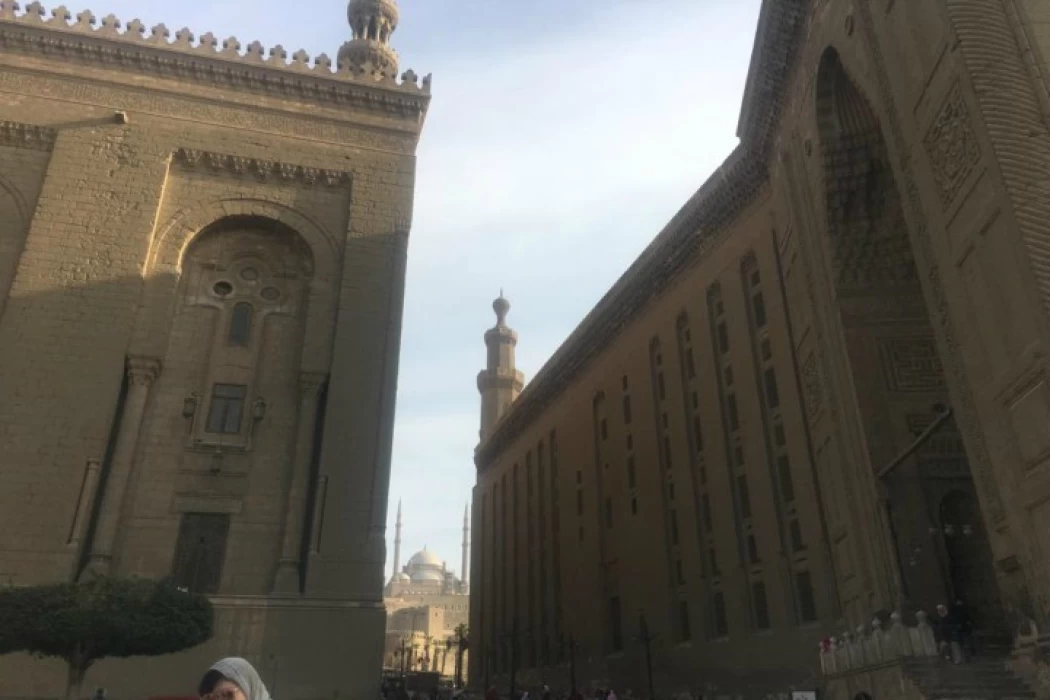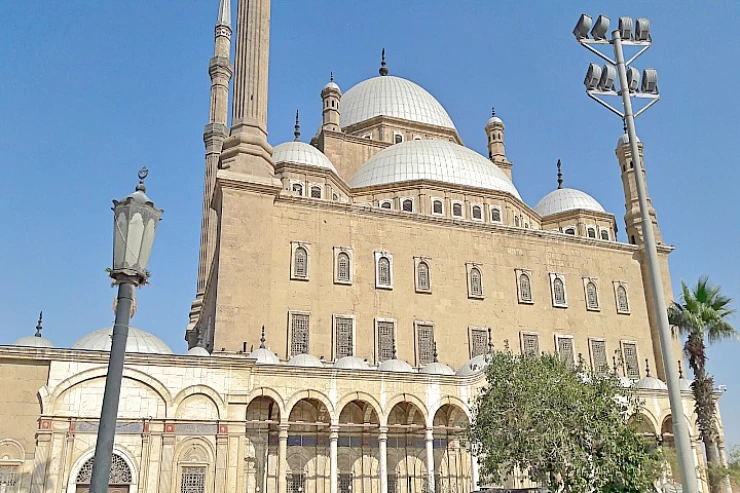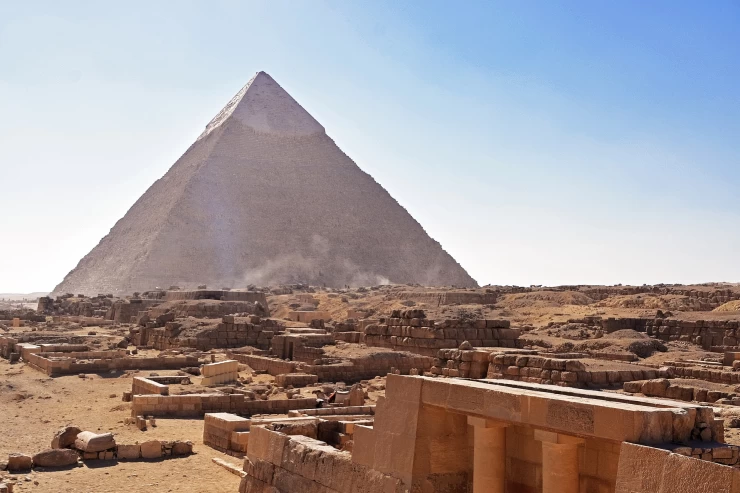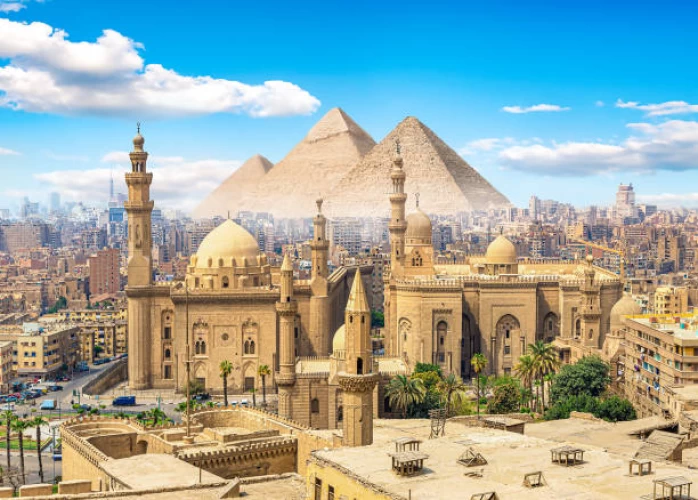
Sultan Hassan Komplex
51/5000 Moschee und Madrasa von Sultan Hassan
Der Sultan Hassan Complex kombinierte die Größe des Gebäudes, die Genauigkeit der Branche und die Vielfalt der Dekoration und verdiente es daher, als architektonisches Meisterwerk und Stolz der alten islamischen Kunst beschrieben zu werden.
Islamisches Kairo
In einem Buch über Ägypten heißt es über die monumentale Moschee von "Gomar": "Es ist eines der schönsten Gebäude Kairos und des Islam, wegen seiner hohen Kuppel, der Höhe seines Minaretts, des Knochens seiner Breite und des Luxus und Fülle seiner Dekoration. Al-Maqrizi beschrieb es als "einer der muslimischen Tempel ist im Islam nicht bekannt. Dies ahmt die Moschee nach. ""
Das größte Gebäude im islamischen Kairo neben der höchsten Tür vor allem zwischen allen Moscheen und Schulen. Der Komplex besteht aus Musque, Schule und Übernachtung für Schüler und Lehrer. Er verfügt über vier Schulen, in denen die vier sunnitischen Riten unterrichtet werden.
Die Moschee von Sultan Hassan gilt als eine der umfassendsten Moscheen in Kairo oder vielleicht auf der ganzen Welt und insbesondere im islamischen Kairo.
Sie ist 150 m lang und erstreckt sich über eine Fläche von 7.906 m². Die Mauern sind 36 m hoch und das höchste Minarett 68 m. Besucher können den Komplex durch ein hohes Portal betreten, das ein Kunstwerk außergewöhnlicher Kunst ist. Ein dunkler Durchgang mit relativ niedrigen Decken führt zum hellen Glanz, einem offenen Innenhof mit kreuzförmigem Grundriss.
Die Zentren des Hofes befinden sich auf einem gewölbten Waschbrunnen, der wahrscheinlich eine osmanische Ergänzung war. Auf vier Seiten der Terrasse ragen runde Iwans (Wohnzimmer) empor, die von hängenden Lampenketten und rot-schwarzen Rändern gepflegt werden. Der berühmte Mamluk Sultan Hassan, der die Moschee von Sultan Hassan gründete, ist der Sohn des großen Mamluk Sultans Al-Nasser Mohamed Ibn Qalawoun.
Er regierte zwei unterbrochene Regierungszeiten, das erste Mal im Jahr 1347, als er 13 Jahre alt war, um von den anderen Mamluk-Prinzen und Generälen entthront zu werden. Das zweite Mal war 1356 n. Chr., Und bevor er Zeit hatte, der Macht der Fürsten und hohen Beamten ein Ende zu setzen, machten sie eine Revolution gegen ihn.
Es hieß, er sei aus der Zitadelle von Salah Eldin geflohen, aber er wurde gefunden und eingesperrt, um nie wieder gesehen zu werden. Am scheinbarsten wurde er 16 Jahre nach seiner Thronbesteigung getötet. Er ließ 10 Söhne und 6 Töchter zurück.
Die Moschee wurde nach dem System von Schulen mit orthogonaler Planung erbaut. Jede Schule wird als kleine Moschee betrachtet. Jede von ihnen ist dem Unterrichten einer der vier islamischen Schulen „Shafi'i, Maliki, Hanbali und Hanafi“ gewidmet. die größte dieser Hanafi-Schulen.
Zwanzig Bewerber und drei Lehrassistenten, und jeder von ihnen erhielt ein Gehalt entsprechend seiner Arbeit. Er ernannte einen Lehrer für die Interpretation des Korans und mit ihm dreißig Schüler. Er ernannte auch einen Lehrer für den Hadith des Propheten und erhielt ein Gehalt von 300 Dirham.
Wie im Mamluk-Stil der Architekturplanung üblich, ist der Qibla Iwan der größte der 4 Iwans in der Moschee. Die aus Marmor gefertigte Bank, die als Bank des Repeaters vor dem Qibla Iwan bekannt ist, ist (Dekkat Al-Mouballegh) über 8 Säulen und 3 Pfeilern errichtet.
Hinter dem Mihrab öffnen sich zwei Türen in der Quibla-Mauer, die zu einer Mausoleumkuppel führen, in der der Sultan angeblich begraben sein soll. Das Mausoleumdach ist 21 Quadratmeter groß und die Dekoration ähnelt der des Qibla Iwan.
In der Nähe der Moschee von Sultan Hassan können Sie besuchen:
Die Moschee von Ibn Tulun.
Die Zitadelle von Salah Eldin.
Al Azhar Moschee
Erleben Sie den Zauber Ägyptens, wo alles beginnt, mit dem professionellen Team von Cairo Top Tours. Starten Sie jetzt Ihr Abenteuer und erleben Sie den besten Urlaub in Ägypten.
Sie finden hier die besten Ägypten-Osterangebote und -Urlaube 2022. Der Frühling in Ägypten ist perfekt und die Atmosphäre ist unsagbar schön. Wir organisieren tolle und unterhaltsame Ägypten Ausflüge wie Kairo Tagestouren.
Schauen Sie sich unsere Ausflüge und Reisen mit angemessenen Preisen an, die für alle Arten von Touristen im Jahr 2022 geeignet sind, sowie Ägypten Landausflüge, zusätzlich zu Kairo Tagestouren vom Flughafen und Kairo Zwischenlandung Tour. Sie können das antike Theben erkunden, beginnend mit dem Tal der Könige und dem Westufer von Luxor, sowie den Karnak-Tempel und den Luxor-Tempel. Ägypten Touren erweitern, um den Tempel von Edfu von Gott Horus der Falke, und Kom Ombo Tempel und Abu Simbel zu decken.
All dies während Assuan-Tagestouren und Luxor-Tagestouren. Das Rote Meer ist einer der malerischsten Orte, die Sie in Ägypten besuchen können, genießen Sie einige Meeresabenteuer und Wanderaktivitäten wie Hurghada Tagestouren und Sharm El Sheikh Ausflüge. Sichern Sie sich jetzt Ihren Platz in unseren Ägypten-Reisepaketen und Wüstensafari-Trips, um von Kairo aus die Oasen Siwa, Bahriya und Farafra sowie die Oasen Dakhla und Kharga zu bereisen! Wir sehen uns wieder.
Wir können Sie über einen besonderen Ort in Ägypten unterrichten, den Temsah-See oder Krokodilsee. Wir können Sie auch zu all den lustigen und interessanten Orten dort bringen.
The Mosque and Madrasa of Sultan Hassan is one of the most stunning examples of Islamic architecture in Cairo, and it is not surprising that the mosque is situated around the Citadel of Saladin, in the interior of Old Cairo. The complex embodies the epic proportions of Mamluk architecture and is famous for its great scale, beautiful intricate patterns and detail, and its past. Visitors around the globe make pilgrimages to the beauty and history of this architectural and cultural masterpiece, which is the pride of the Mamluk Sultanate.
Historical Overview
This mosque and khanqah compound construction was commissioned by Sultan Hassan bin al-Nasir Muhammad around the year 1356 AD, and he intended it to be more than a mosque as it would serve as a madrasa (school of study) for the four major Sunni sects of Islam: Hanafi, Maliki, Shafi’i, and Hanbali. The construction of the tomb was commenced in the 1356 Christian era, which took around seven years to complete. It was also used as a place to learn and worship. But the bad part was that, alas, within a matter of hours, after the Sultan ordered his last and grandest design, the Sultan was assassinated, thus enhancing the myth.
The complex was built in one of the cities that over the years have suffered many interruptions within its history, internally due to earthquakes as well as military sieges, some of which rendered its architectural design adversely. But it has remained a significant symbol of Mamluk rule and devotion and continues to be open for worship and visitors.
While the Sultan Hassan Complex has much to offer, its enormous scale is undoubtedly the most impressive feature. The main entry that is just under 26 meters in height leads to a courtyard that is surrounded by walls that rise to a height of 36 meters. The entire mosque covered about 7900 square meters, making it one of the biggest mosques in the globe. The building’s symmetrical stone elevation and rich use of geometrical decor and ornamental monuments are typical Mamluk architectural designs.
Also, within the mosque’s interior—except for the one iwab—which houses four schools of Sunni Islam and a large central courtyard, which is encircled by four iwans. The Iwan located at the center pointing to Mecca is enhanced with elaborate stucco work and marbles, as well as a decorated'mihrab.'.’ The courtyard is also properly arranged with the help of vertical members in the form of columns. The guests will also admire the lofty walls of the space, which have curved ceilings, creating an almost ethereal feeling in the room.
The organization, which is popularly referred to as the madrasa or Islamic institution in its primary sense, was one of the objects of the original vision of the complex. So all four iwans also served as classrooms for one of the Sunni judicial schools. This period also explains the presence of such illustrious personages in the inner chambers surrounded by students hailing from every corner of the Muslim world due to its esteem as the pinnacle of education.
The institution committed to the good health of its students as well. This implied that in addition to regular classes being offered, nutrition, dormitories, and a reading room were also provided to the students. The madrasah is covered by Koranic verses placed on the walls as ornaments and motivational resources for the student scholars who were within its confines.
Equally intriguing is the tomb of Sultan Hassan, which is another distinguishing element of the Sultan Hassan Complex. The tomb is in the back of the main prayer room and is said to be one of the best preserved examples of Mumluk burial architecture. The dome is surmounted by a giant dome that is 21 meters in height and is embellished with beautiful arabesques and inscriptions. Based within the mausoleum, there lies the sarcophagus of Sultan Hassan, encased in walls of marble embedded with Mamluk-style masterpieces.
Interestingly, Sultan Hassan’s body was never interred in this mausoleum, as he was killed before the complex was completed, and his remains were buried elsewhere. Nevertheless, the mausoleum remains a symbolic resting place and is a beautiful tribute to his memory.
The Sultan Hassan Complex is a superlative work of Islamic art and architecture, with every detail thoughtfully designed and executed to fit the Mamluk style. The walls and ceilings are clad in arabesques, geometric designs, calligraphy, and other typical components of Islamic art. The fishtail and stucco carving works, embellished on the surfaces, unequivocally demonstrate the exceptional artistry that went into building the entire complex.
Among the dominant artistic aspects, one cannot miss the beautiful wooden mashrabiya, which has elaborate floral and geometric carvings in it, encouraging the eye to explore its design. In addition to enhancing the beauty of the complex, these screens also provide ventilation as well as privacy. Another thing that adds beauty to the mosque is its mihrab, which is made of marble and embellished with decorative panels and mosaics that instill a certain level of spirituality.


















